
If you want your business to grow, truly understanding your customers is non-negotiable.That’s where a client profile comes in — it’s like a deceive sheet that makes a difference you interface with the correct individuals within the right way. A client profile goes past essential socioeconomics; it burrows into your perfect customer’s way of life, inspirations, torment focuses, and behavior. When you know what makes your customers tick, you can create more targeted marketing campaigns, develop products they actually need, and provide experiences that feel personal and relevant.
In today’s crowded market, customers expect more than one-size-fits-all messaging. They want brands that understand them — and a well-researched customer profile helps you deliver exactly that. Whether you're a startup building your first product or a growing brand refining your marketing strategy, customer profiles can guide smarter decisions across sales, support, and content. In this blog, we’ll break down what a customer profile is, why it’s crucial, how to build one step by step, and how to use it to drive real business results. Let’s dive in!
Table of Contents:
- What is a Customer Profile?
- Why is a Customer Profile Important?
- Key Components of a Customer Profile
- How to Create a Data-Rich Customer Profile?
- Tips for Using Customer Profiles to Grow Your Business
- Common Mistakes to Avoid
- Conclusion
- Customer Profile Frequently Ask questions (FAQs)
What is a Customer Profile?
A customer profile is a comprehensive, data-driven description of your ideal customer — the kind of person most likely to engage with your brand, purchase your products, and stay loyal over time. It includes both demographic and psychographic details such as:
- Age, gender, location, income level (demographics).
- Interests, goals, pain points, buying behavior (psychographics).
- Online behavior, purchase history, preferred channels (behavioral insights).
Think of it like creating a character in a movie or novel. You’re not just naming them and saying “they’re 35 and live in New York.” You’re diving into their mindset: What do they care about? What are they struggling with? Where do they hang out online? What motivates them to buy?
For example, let’s say you run an online skincare brand. Your ideal customer profile might look something like:
- Name: Sarah, 32.
- Occupation: Digital marketer.
- Location: San Francisco.
- Pain Point: Struggles with adult acne and sensitive skin.
- Buying Motivation: Looks for clean, cruelty-free products with proven results.
- Preferred Channels: Instagram, YouTube, and product reviews.
- Behavior: Buys after seeing influencer recommendations and reading online testimonials.
With this profile in hand, your marketing team knows what kind of content to create, which platforms to focus on, and how to speak Sarah’s language. Now, this is different from a broad target audience like “millennial women in urban areas.” A customer profile is more specific and actionable — and it’s usually built using actual customer data, feedback, analytics, surveys, and CRM insights. It’s not just a guess — it’s backed by real evidence.
Why is a Customer Profile Important?
Building a customer profile isn’t just a trendy marketing exercise. It’s a strategic powerhouse that impacts almost every area of your business. Here’s a deeper look into why it truly matters:
1. Improves Marketing Efficiency
After you know precisely who you're talking to, your campaigns gotten to be laser-focused. Rather than casting a wide net and trusting somebody chomps, you’re talking specifically to the individuals most likely to change over. You'll :
- Type in personalized advertisement duplicate and emails.
- Select the proper stages (Facebook? LinkedIn? TikTok?).
- Make offers that feel tailor-made.
This leads to superior ROI, higher engagement, and lower client procurement costs.
2. Enhances Product Development
A clear profile reveals what your customers actually need — not just what you think they want. That means:
- Building features or products that solve real problems.
- Prioritizing updates based on customer pain points.
- Validating new ideas with the right audience.
Imagine launching a new product and already knowing it’s what your audience has been asking for. That’s the power of customer profiling.
3. Boosts Customer Experience
Today’s customers expect personalized, seamless experiences. A good customer profile helps you deliver exactly that:
- Personalized website content and product recommendations.
- Tailored support and onboarding processes.
- Relevant follow-ups based on behavior and preferences.
When customers feel seen and understood, they’re more likely to have a positive brand experience — and tell others about it too.
4. Increases Customer Retention
Engaged, satisfied customers come back. When you know your audience well:
- You can keep conversations going with relevant content.
- Anticipate when they’re likely to need more support or new products.
- Address churn signals before they escalate.
That translates to higher lifetime value, better reviews, and a growing loyal customer base.
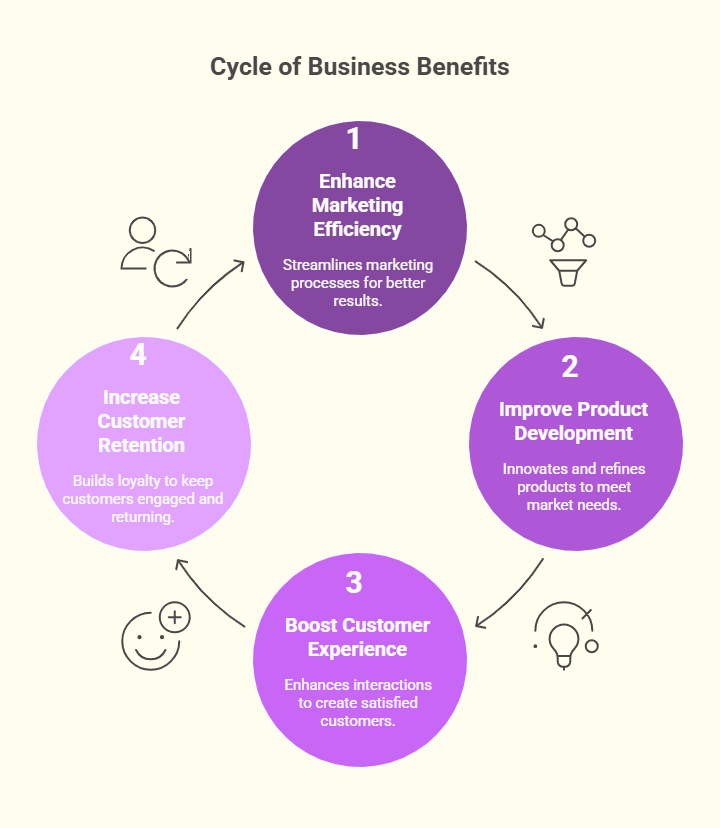
Key Components of a Customer Profile
Making a awesome client profile is like amassing a confuse — the more pieces you incorporate, the clearer the total picture gets to be. Each component gives you more profound understanding into how your perfect client considers, carries on, and makes obtaining choices. Here's a nitty gritty see at the basic building squares:
1. Demographic Information
These are the basic facts about your customer — the kind of information that helps you categorize and segment your audience at a high level.
- Age: Are you targeting Gen Z, Millennials, Gen X, or Baby Boomers? Age influences everything from content tone to platform choice.
- Gender: While you shouldn’t stereotype, knowing gender can help tailor messaging, product design, or ad visuals — especially if your product serves a specific group.
- Location: Geographic data helps you localize campaigns, understand climate or cultural trends, and even plan logistics (like shipping or local store events).
- Income Level: Someone with a tight budget vs. someone who can spend freely requires completely different messaging and product positioning.
- Education: Higher education levels might indicate a preference for more detailed, research-driven content.
- Occupation: Are they freelancers, business owners, corporate employees, or students? Occupation can reveal goals, pain points, and available time or money.
- Why it matters: Demographics are your starting point — they help narrow down who you’re talking to.
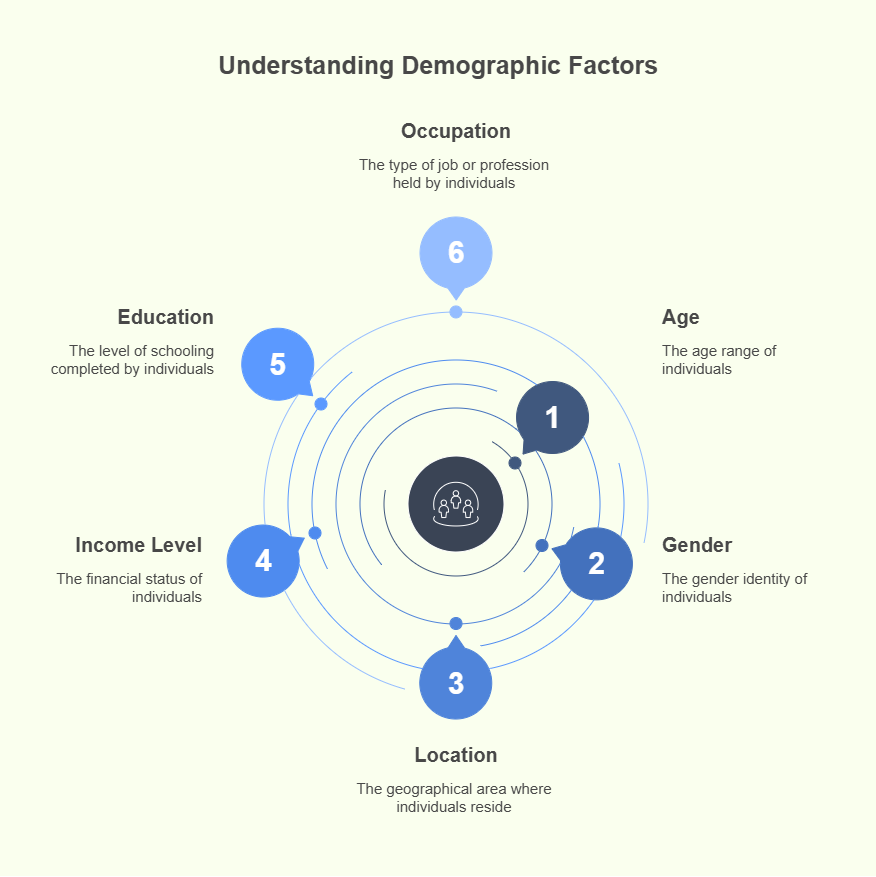
2. Psychographic Information
Now we dig deeper. Psychographics uncover the emotional and psychological traits of your ideal customer — what drives them, what they value, and how they view the world.
- Interests and Hobbies: Are they into fitness, gaming, fashion, travel, or sustainability? This helps you speak their language and connect on a human level.
- Values and Beliefs: Do they prioritize eco-conscious brands? Support local businesses? Choose function over flash? Aligning with your audience's values builds trust.
- Lifestyle Choices: Are they minimalist or luxury seekers? Do they live fast-paced city lives or prefer slow, rural routines?
- Personality Traits: Are they analytical, adventurous, cautious, or spontaneous? Knowing this can shape your product messaging and call-to-action (CTA) strategies.
- Why it matters: Psychographics humanize your audience. You're not just marketing to a 35-year-old woman — you're connecting with Sarah, a health-conscious yoga lover who values self-care and community.
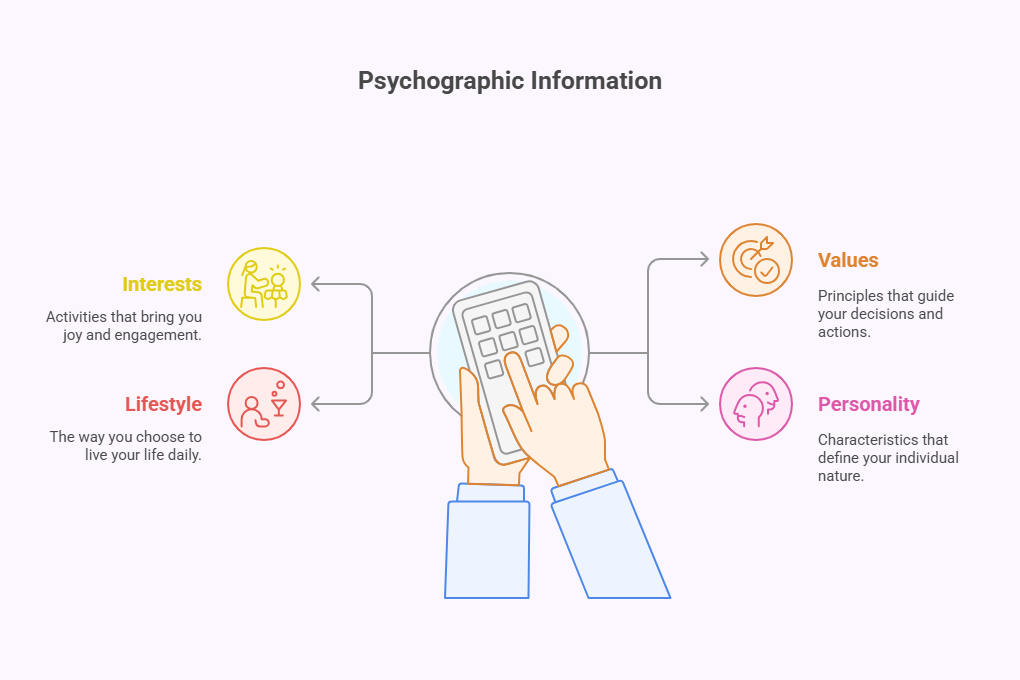
3. Behavioral Data
This tells you how your customers act, especially in relation to your brand. It’s one of the most actionable data sets and comes directly from analytics, CRM tools, or surveys.
- Buying Habits: Do they make impulse buys or need a long decision-making period? Are they loyal to one brand or switch often?
- Preferred Channels: Do they prefer shopping in-store, online, or through mobile apps? Do they engage with email, Instagram, or YouTube more often?
- Brand Interactions: How often do they engage with your emails, website, or social media posts? What types of content do they click or share?
- Product Usage Patterns: How often do they use your product? Do they use all the features or just a few? Are they power users or beginners?
- Why it matters: Behavioral data lets you optimize the customer journey by tailoring content, offers, and experiences based on real-world actions.
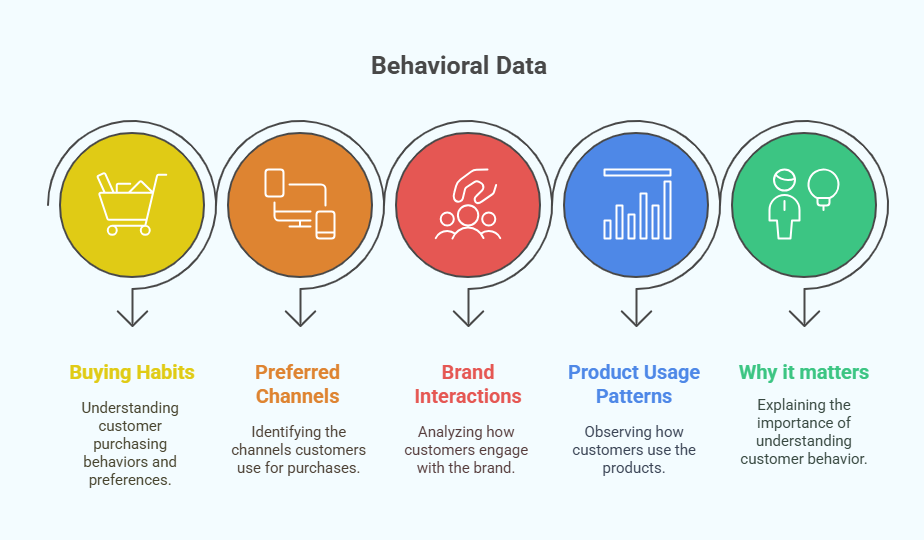
4. Pain Points and Challenges
This is where the real empathy work happens. Pain points are the frustrations, barriers, or problems that your customer is actively trying to solve.
What problems are they facing? Are they overwhelmed with options? Struggling to find time? Dealing with outdated tools or poor service?
What’s preventing them from buying or engaging? Price? Confusion? Lack of trust? Fear of making a wrong decision? Why it matters: Your product or service should be a solution. When you understand the problems your audience faces, you can position yourself as the answer — clearly and persuasively.
5. Goals and Motivations
This focuses on the “why” behind customer actions — what outcomes they’re hoping for, and what desires push them forward.
What drives their decisions? Are they looking to save time, impress others, feel healthier, grow their business, or achieve a personal goal?
What benefits are they seeking? Faster delivery? Simpler processes? Peace of mind? Prestige? Practical value?
Why it matters: People don’t buy products — they buy results. Knowing what your customers want to achieve helps you craft benefits-focused messaging that converts.
How to Create a Data-Rich Customer Profile?
Building an viable client profile takes a mix of inquire about, information collection, and investigation. Here’s a basic step-by-step direct:
Step 1: Collect Information
Utilize studies, interviews, and client criticism shapes. Don’t disregard analytics apparatuses that track behavior on your site and social media.
Step 2: Fragment Your Clients
Gather clients based on shared characteristics to make diverse profiles — not each client fits one form!
Step 3: Analyze Your Information
Seek for designs and patterns. What do your best clients have in common? What challenges do they confront?
Step 4: Make Your Profile Record
Summarize your discoveries in an easy-to-read organize. Incorporate a anecdotal “persona” with a title, photo, and story for a human touch.
Step 5: Upgrade Frequently
Client inclinations alter, so keep your profiles new with continuous information.
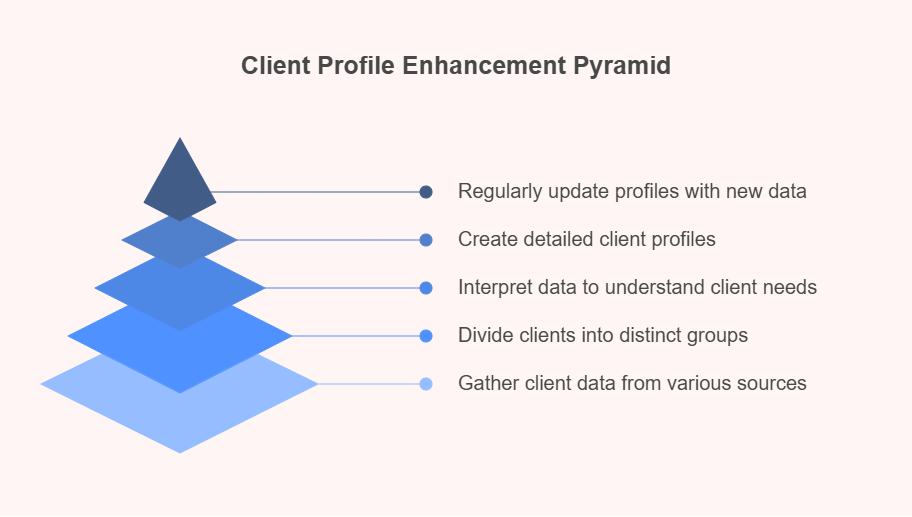
Tips for Using Customer Profiles to Grow Your Business
Customer profiles aren’t just a marketing document to tuck away in a slide deck — they’re powerful, practical tools that can help you make smarter decisions across your entire business. Here’s how you can put them to work:
1. Personalize Marketing Campaigns
Customer profiles give you rich insights into what your audience cares about, how they communicate, and what kind of messaging resonates with them. Use this to:
- Craft relevant ads that speak to specific pain points or desires.
- Choose the right channels — some customers live on Instagram, others prefer email or LinkedIn.
- Segment your email lists to send tailored offers, product updates, or educational content.
- Example: If your profile says one segment prefers eco-friendly living, you might send them campaigns highlighting your sustainable practices and packaging — instead of your lowest prices.
2. Design Targeted Content
Once you know what your audience is struggling with or aiming for, you can create content that truly adds value. This means:
- Writing blog posts that answer specific questions your customers have.
- Producing videos or tutorials that solve real problems for them.
- Creating social media content that fits their lifestyle or humor style.
- Example: If one of your profiles is a time-strapped working mom, a blog titled “5-Minute Solutions for Staying Organized” will speak directly to her — and build trust.
3. Improve Customer Support
Support is one of the most overlooked areas where customer profiles can make a huge difference. By understanding your customer’s preferred communication style, pain points, and tech-savviness, your support team can:
- Offer faster, more empathetic help.
- Provide proactive suggestions based on common behaviors or issues.
- Route queries through the right channels — like chat for Gen Z or phone for older customers.
- Example: If your customer profile shows a preference for self-service, invest in a knowledge base or chatbot — not just phone support.
4. Guide Product Development
Customer profiles help product and design teams make data-informed decisions. Use them to:
- Develop features that solve real, identified problems.
- Create pricing tiers that match customer income levels and usage needs.
- Adjust packaging, naming, or user experience (UX) to match user expectations.
- Example: If your ideal customer is a freelancer who values simplicity, your product shouldn’t be overloaded with enterprise-level features they’ll never use.
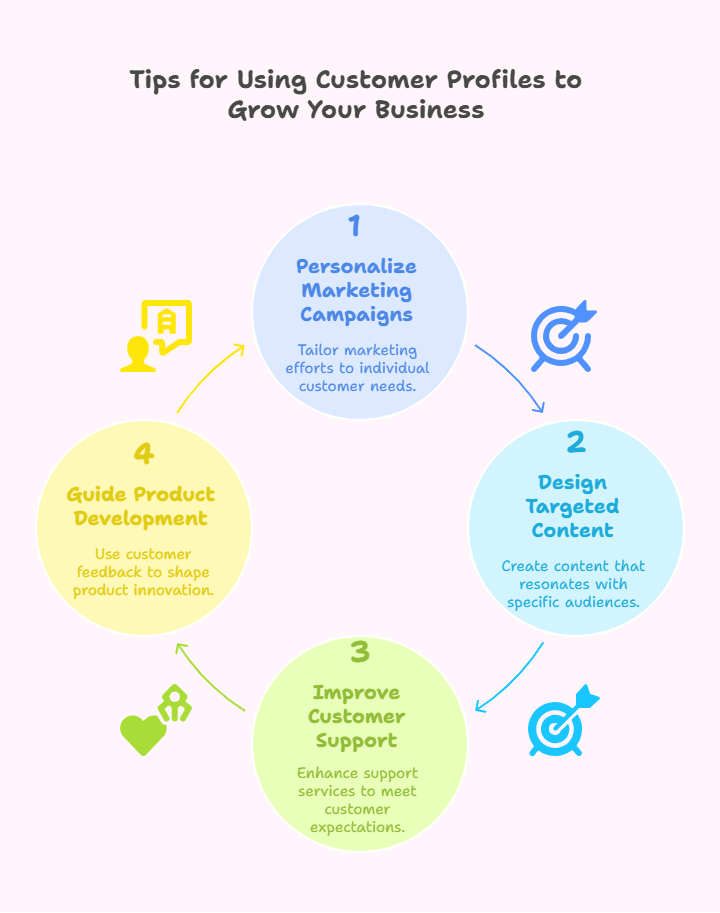
Common Mistakes to Avoid
Even though customer profiles are powerful, many businesses make avoidable mistakes that water down their effectiveness. Here are some of the most common pitfalls — and how to sidestep them:
1. Relying on Assumptions
- One of the biggest mistakes is building your customer profile based on gut feeling or stereotypes rather than actual data.
- Don’t assume your customer is a 35-year-old dad who loves golf just because your CEO is.
- Do use surveys, website analytics, sales data, CRM insights, and feedback to validate your assumptions.
- Why it hurts: Decisions made on assumptions often miss the mark, waste marketing budgets, and alienate potential customers.
2. Creating Too Broad Profiles
- A vague profile like “Women aged 25–45 who like fashion” is too generic to be useful. If everyone is your customer, no one really is.
- Don’t try to create a single profile for all users.
- Do narrow it down: create multiple specific profiles if needed (e.g., “Budget-conscious moms looking for sustainable kids’ fashion” vs. “Young professionals seeking designer styles on-the-go”).
- Why it hurts: Broad profiles make it hard to personalize content or ads in a way that truly connects.
3. Ignoring Changes in Customer Behavior
- Customer behavior and expectations shift over time — especially with market trends, economic shifts, or tech changes.
- Don’t treat your profile as a one-and-done exercise.
- Do revisit and revise your profiles regularly, ideally every quarter or after a major campaign, product launch, or market event.
- Why it hurts: Outdated profiles can lead to irrelevant offers, missed opportunities, and declining engagement.
4. Not Sharing Profiles Internally
- Your marketing team might have beautifully crafted customer profiles — but if your sales, product, and support teams don’t know about them, that’s a missed opportunity.
- Don’t keep profiles locked away in a marketing doc.
- Do integrate them across departments — through training sessions, CRM notes, or customer journey maps.
- Why it hurts: Consistency is key. If marketing promotes benefits A and B, but sales pushes C and D, customers get confused — and trust erodes.
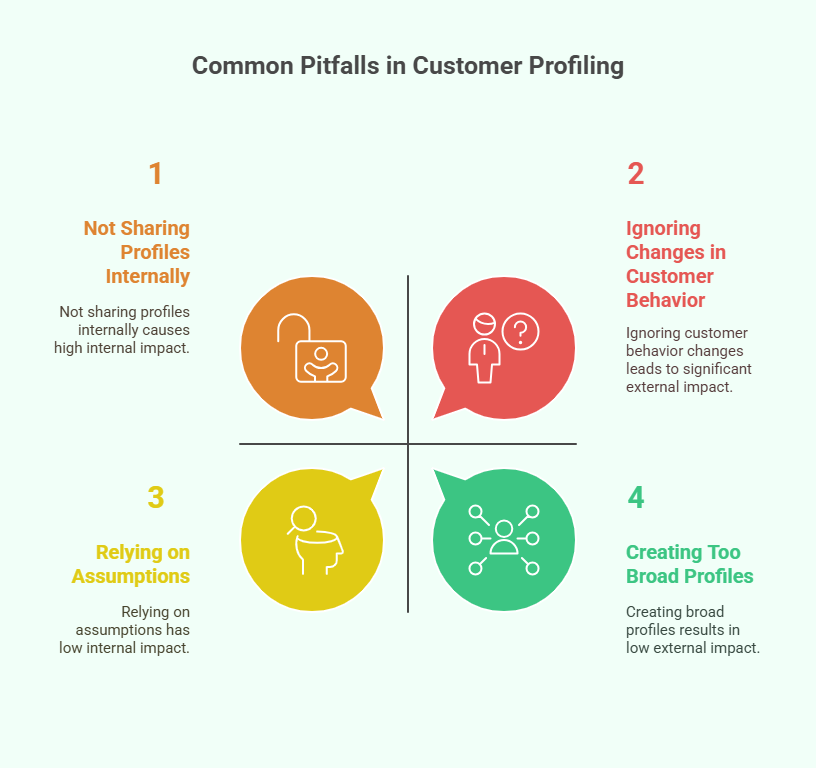
Conclusion
Making a point-by-point, data-rich client profile is one of the most intelligent moves you'll make for your business. It turns guesswork into clarity and helps you build meaningful connections that drive growth. Whether you’re a startup or an established brand, investing time in understanding your customers will lead to stronger marketing, better products, and happier clients.
Platforms like PrimeRole can be a game-changer in this journey—helping you collect, segment, and analyze customer data more effectively so you can build precise client profiles without the manual hassle. Start gathering insights today, craft your ideal customer profile, and watch your business thrive!
Build Stronger Campaigns with Smarter Customer Profiles!
Learn how detailed customer insights can power personalized marketing and boost ROI.
Customer Profile Frequently Ask questions (FAQs)
What’s the difference between a customer profile and a buyer persona?
They’re very similar, but a buyer persona often includes more detailed narratives and emotional triggers, while a customer profile focuses on data-backed traits.
How often should I update my customer profiles?
Ideally, review and update your profiles every 6-12 months or whenever you notice significant changes in customer behavior.
Can small businesses benefit from customer profiles?
Absolutely! Small businesses can use profiles to compete by understanding niche audiences better than bigger competitors.
